Social Work Policy Draft: Youth Homelessness in New South Wales
VerifiedAdded on 2022/11/07
|8
|1753
|420
Report
AI Summary
This report presents a policy draft focused on addressing youth homelessness in New South Wales (NSW), Australia. The student's work begins with an executive summary highlighting the significance of homelessness as a major social issue in Australia, particularly in NSW, and the need for effective policies. The report provides a critical analysis of homelessness, defining it from various perspectives, including cultural, primary, secondary, and tertiary levels, and discusses the rising rates of homelessness in NSW. It also identifies key measures and recommendations for policy researchers and legislators, emphasizing the importance of understanding the root causes of homelessness, focusing on the individual capabilities of homeless youth, and encouraging collaboration among public and private organizations. The report also analyzes the influence of various organizations in the decision-making process and suggests specific approaches to address the issues of homeless youth, including vocational training, addressing social inequality, and implementing new housing policies. The report references several academic sources to support its arguments and recommendations.
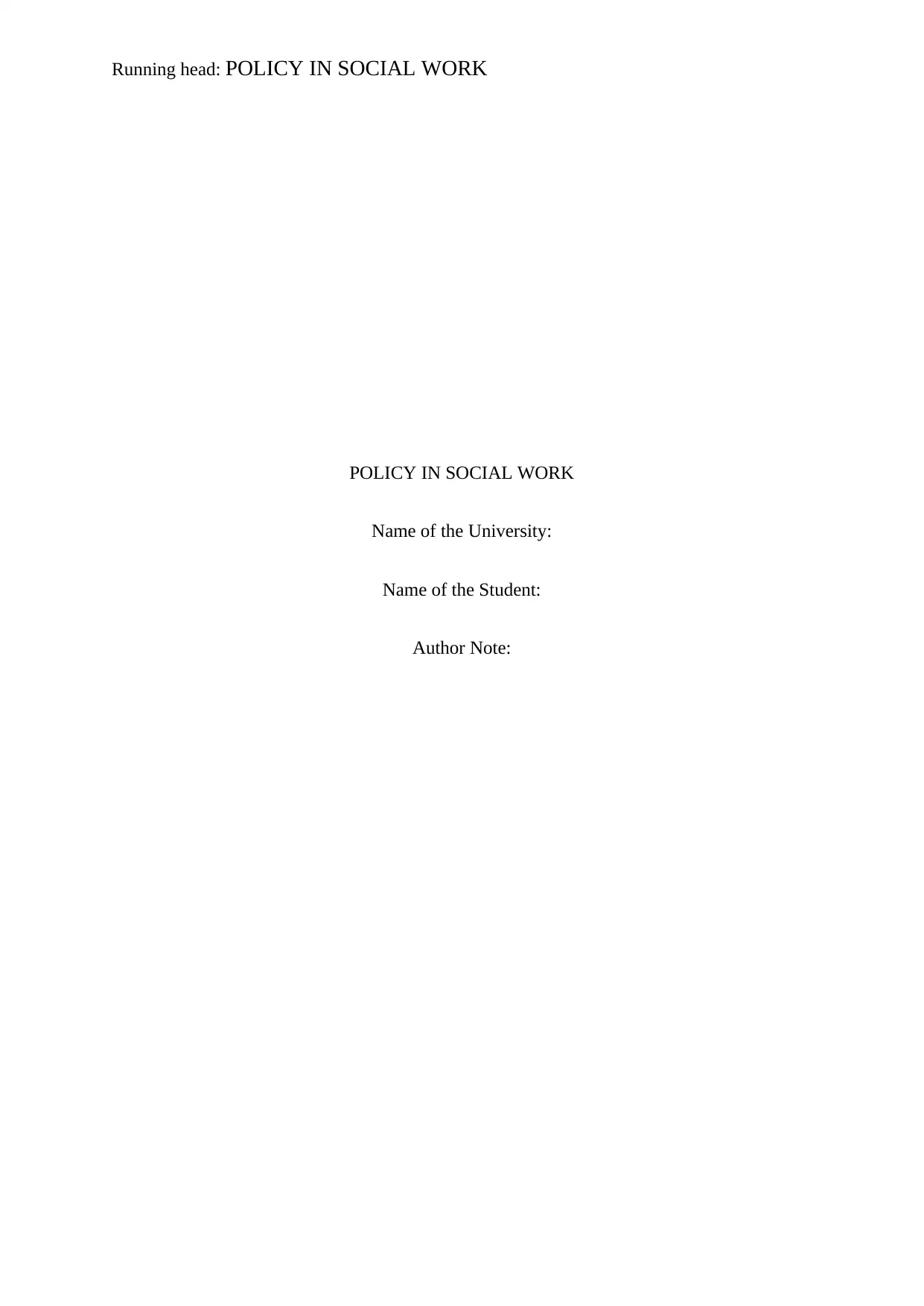
Running head: POLICY IN SOCIAL WORK
POLICY IN SOCIAL WORK
Name of the University:
Name of the Student:
Author Note:
POLICY IN SOCIAL WORK
Name of the University:
Name of the Student:
Author Note:
Paraphrase This Document
Need a fresh take? Get an instant paraphrase of this document with our AI Paraphraser
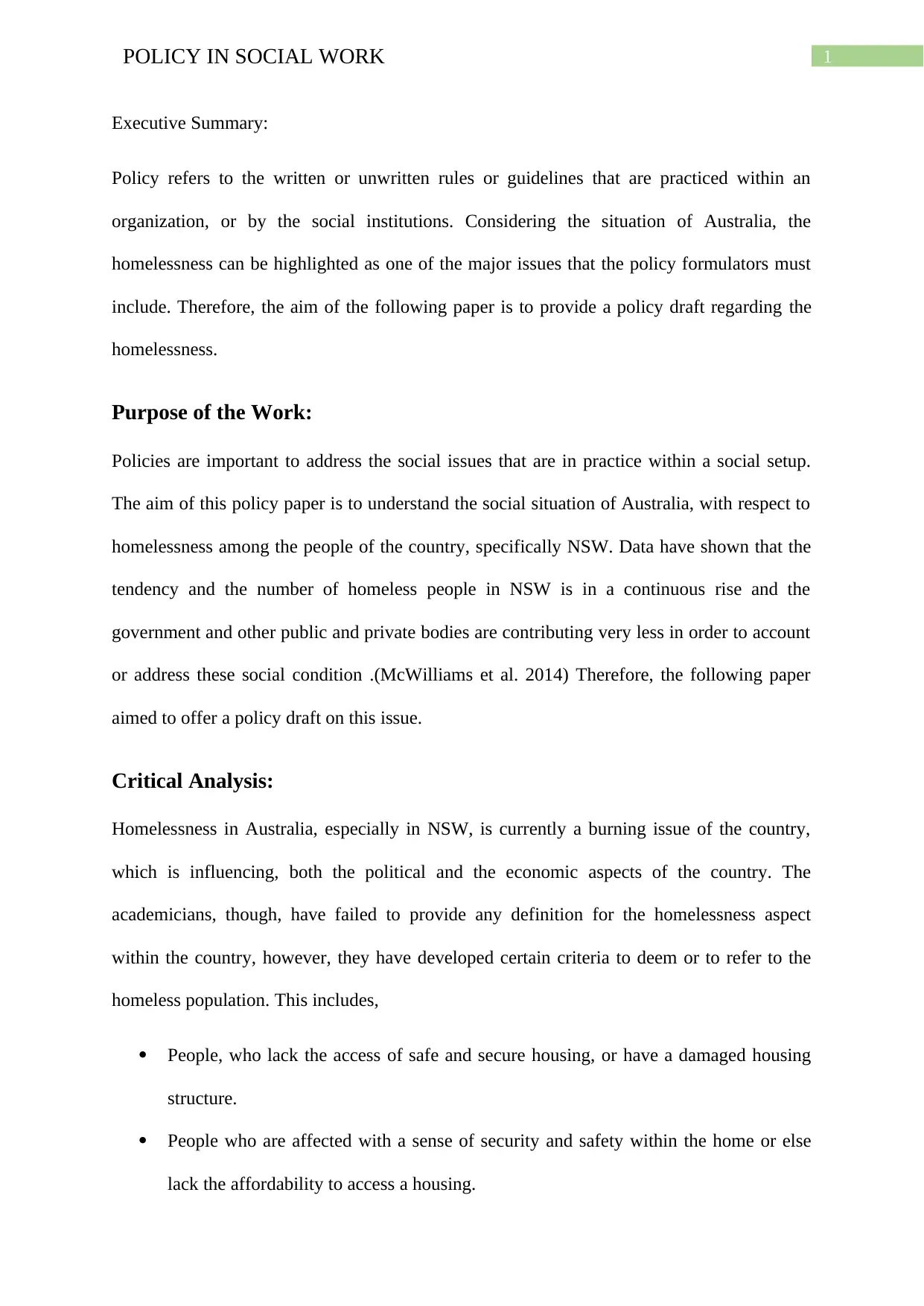
1POLICY IN SOCIAL WORK
Executive Summary:
Policy refers to the written or unwritten rules or guidelines that are practiced within an
organization, or by the social institutions. Considering the situation of Australia, the
homelessness can be highlighted as one of the major issues that the policy formulators must
include. Therefore, the aim of the following paper is to provide a policy draft regarding the
homelessness.
Purpose of the Work:
Policies are important to address the social issues that are in practice within a social setup.
The aim of this policy paper is to understand the social situation of Australia, with respect to
homelessness among the people of the country, specifically NSW. Data have shown that the
tendency and the number of homeless people in NSW is in a continuous rise and the
government and other public and private bodies are contributing very less in order to account
or address these social condition .(McWilliams et al. 2014) Therefore, the following paper
aimed to offer a policy draft on this issue.
Critical Analysis:
Homelessness in Australia, especially in NSW, is currently a burning issue of the country,
which is influencing, both the political and the economic aspects of the country. The
academicians, though, have failed to provide any definition for the homelessness aspect
within the country, however, they have developed certain criteria to deem or to refer to the
homeless population. This includes,
People, who lack the access of safe and secure housing, or have a damaged housing
structure.
People who are affected with a sense of security and safety within the home or else
lack the affordability to access a housing.
Executive Summary:
Policy refers to the written or unwritten rules or guidelines that are practiced within an
organization, or by the social institutions. Considering the situation of Australia, the
homelessness can be highlighted as one of the major issues that the policy formulators must
include. Therefore, the aim of the following paper is to provide a policy draft regarding the
homelessness.
Purpose of the Work:
Policies are important to address the social issues that are in practice within a social setup.
The aim of this policy paper is to understand the social situation of Australia, with respect to
homelessness among the people of the country, specifically NSW. Data have shown that the
tendency and the number of homeless people in NSW is in a continuous rise and the
government and other public and private bodies are contributing very less in order to account
or address these social condition .(McWilliams et al. 2014) Therefore, the following paper
aimed to offer a policy draft on this issue.
Critical Analysis:
Homelessness in Australia, especially in NSW, is currently a burning issue of the country,
which is influencing, both the political and the economic aspects of the country. The
academicians, though, have failed to provide any definition for the homelessness aspect
within the country, however, they have developed certain criteria to deem or to refer to the
homeless population. This includes,
People, who lack the access of safe and secure housing, or have a damaged housing
structure.
People who are affected with a sense of security and safety within the home or else
lack the affordability to access a housing.
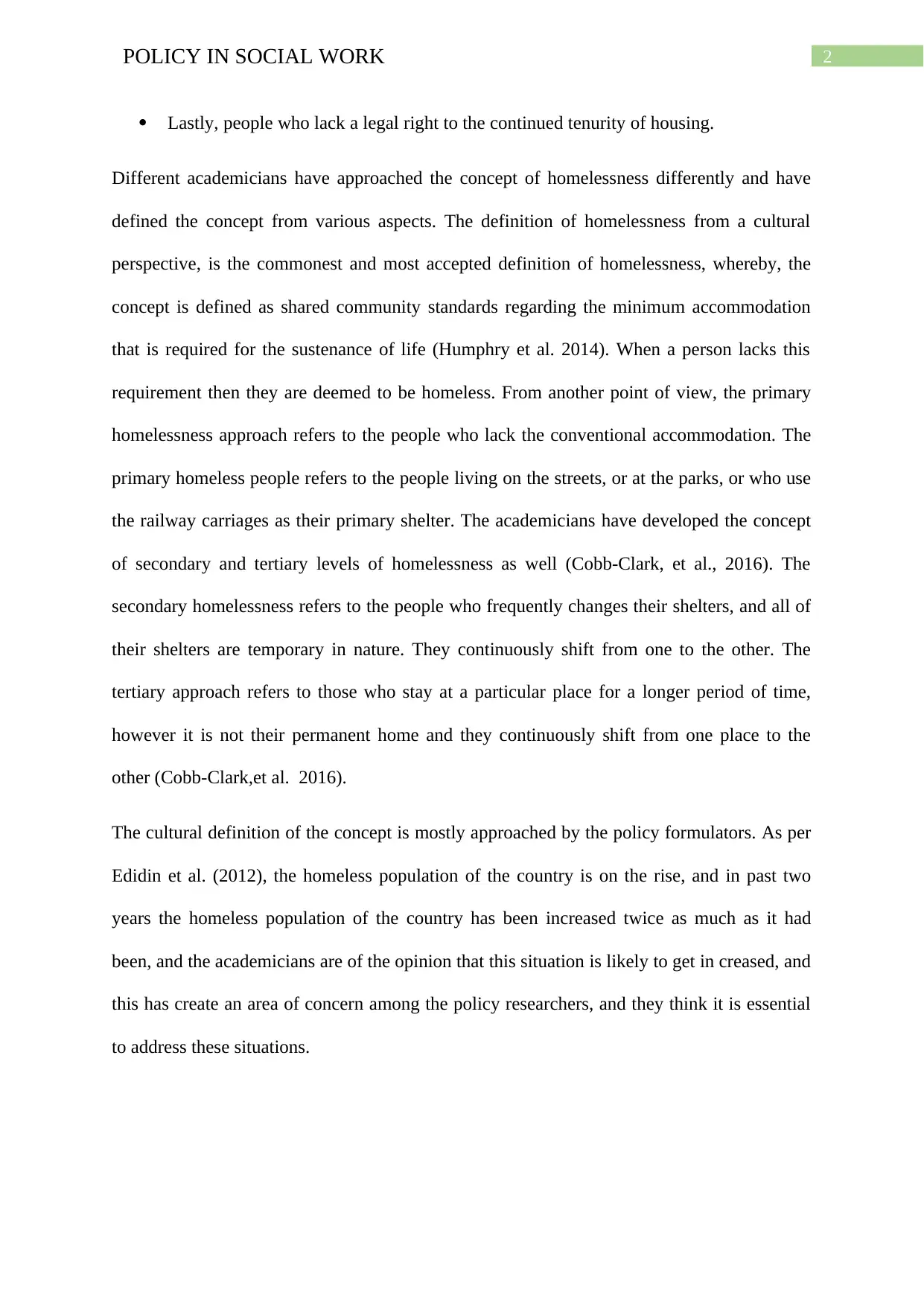
2POLICY IN SOCIAL WORK
Lastly, people who lack a legal right to the continued tenurity of housing.
Different academicians have approached the concept of homelessness differently and have
defined the concept from various aspects. The definition of homelessness from a cultural
perspective, is the commonest and most accepted definition of homelessness, whereby, the
concept is defined as shared community standards regarding the minimum accommodation
that is required for the sustenance of life (Humphry et al. 2014). When a person lacks this
requirement then they are deemed to be homeless. From another point of view, the primary
homelessness approach refers to the people who lack the conventional accommodation. The
primary homeless people refers to the people living on the streets, or at the parks, or who use
the railway carriages as their primary shelter. The academicians have developed the concept
of secondary and tertiary levels of homelessness as well (Cobb-Clark, et al., 2016). The
secondary homelessness refers to the people who frequently changes their shelters, and all of
their shelters are temporary in nature. They continuously shift from one to the other. The
tertiary approach refers to those who stay at a particular place for a longer period of time,
however it is not their permanent home and they continuously shift from one place to the
other (Cobb-Clark,et al. 2016).
The cultural definition of the concept is mostly approached by the policy formulators. As per
Edidin et al. (2012), the homeless population of the country is on the rise, and in past two
years the homeless population of the country has been increased twice as much as it had
been, and the academicians are of the opinion that this situation is likely to get in creased, and
this has create an area of concern among the policy researchers, and they think it is essential
to address these situations.
Lastly, people who lack a legal right to the continued tenurity of housing.
Different academicians have approached the concept of homelessness differently and have
defined the concept from various aspects. The definition of homelessness from a cultural
perspective, is the commonest and most accepted definition of homelessness, whereby, the
concept is defined as shared community standards regarding the minimum accommodation
that is required for the sustenance of life (Humphry et al. 2014). When a person lacks this
requirement then they are deemed to be homeless. From another point of view, the primary
homelessness approach refers to the people who lack the conventional accommodation. The
primary homeless people refers to the people living on the streets, or at the parks, or who use
the railway carriages as their primary shelter. The academicians have developed the concept
of secondary and tertiary levels of homelessness as well (Cobb-Clark, et al., 2016). The
secondary homelessness refers to the people who frequently changes their shelters, and all of
their shelters are temporary in nature. They continuously shift from one to the other. The
tertiary approach refers to those who stay at a particular place for a longer period of time,
however it is not their permanent home and they continuously shift from one place to the
other (Cobb-Clark,et al. 2016).
The cultural definition of the concept is mostly approached by the policy formulators. As per
Edidin et al. (2012), the homeless population of the country is on the rise, and in past two
years the homeless population of the country has been increased twice as much as it had
been, and the academicians are of the opinion that this situation is likely to get in creased, and
this has create an area of concern among the policy researchers, and they think it is essential
to address these situations.
⊘ This is a preview!⊘
Do you want full access?
Subscribe today to unlock all pages.

Trusted by 1+ million students worldwide
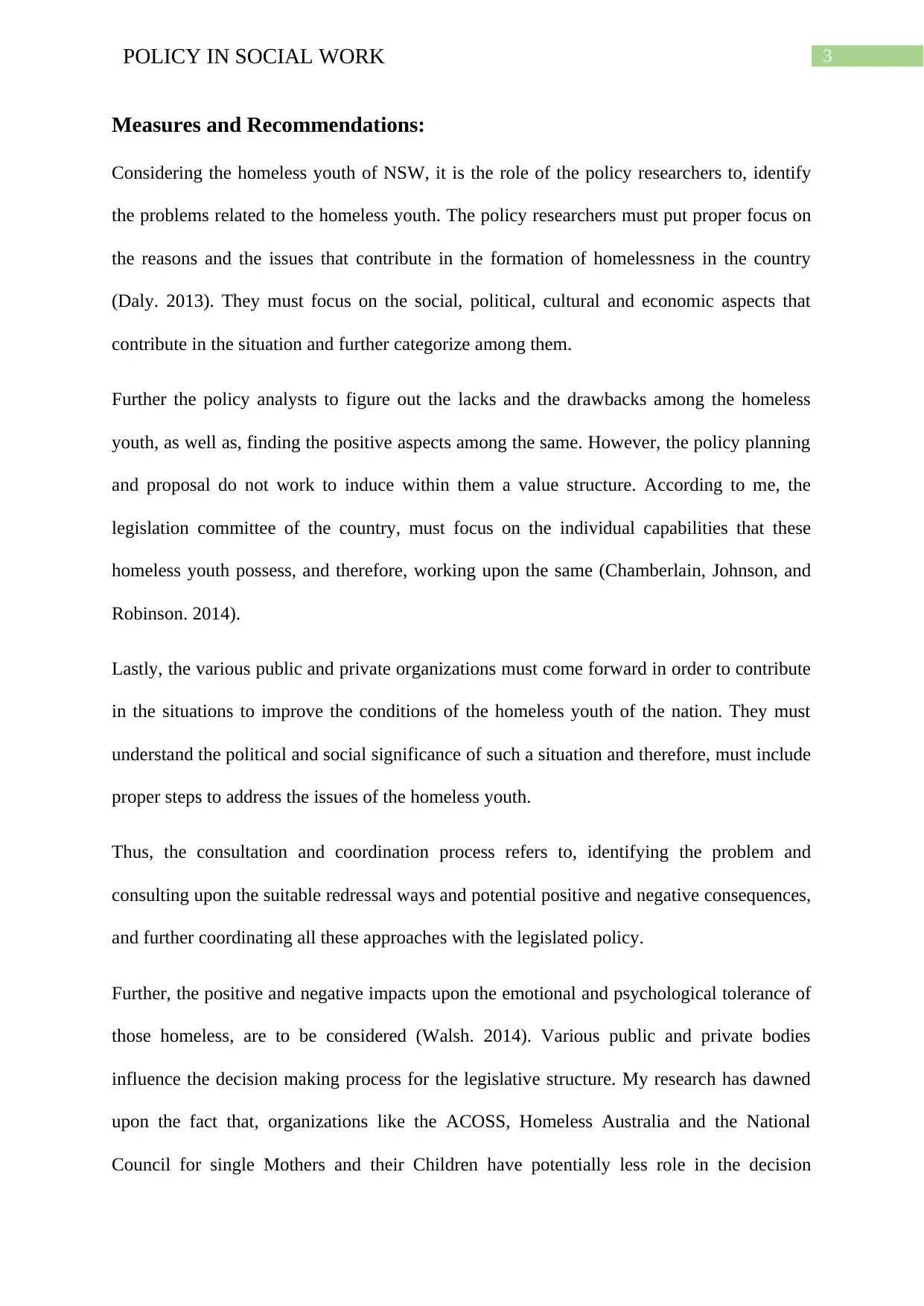
3POLICY IN SOCIAL WORK
Measures and Recommendations:
Considering the homeless youth of NSW, it is the role of the policy researchers to, identify
the problems related to the homeless youth. The policy researchers must put proper focus on
the reasons and the issues that contribute in the formation of homelessness in the country
(Daly. 2013). They must focus on the social, political, cultural and economic aspects that
contribute in the situation and further categorize among them.
Further the policy analysts to figure out the lacks and the drawbacks among the homeless
youth, as well as, finding the positive aspects among the same. However, the policy planning
and proposal do not work to induce within them a value structure. According to me, the
legislation committee of the country, must focus on the individual capabilities that these
homeless youth possess, and therefore, working upon the same (Chamberlain, Johnson, and
Robinson. 2014).
Lastly, the various public and private organizations must come forward in order to contribute
in the situations to improve the conditions of the homeless youth of the nation. They must
understand the political and social significance of such a situation and therefore, must include
proper steps to address the issues of the homeless youth.
Thus, the consultation and coordination process refers to, identifying the problem and
consulting upon the suitable redressal ways and potential positive and negative consequences,
and further coordinating all these approaches with the legislated policy.
Further, the positive and negative impacts upon the emotional and psychological tolerance of
those homeless, are to be considered (Walsh. 2014). Various public and private bodies
influence the decision making process for the legislative structure. My research has dawned
upon the fact that, organizations like the ACOSS, Homeless Australia and the National
Council for single Mothers and their Children have potentially less role in the decision
Measures and Recommendations:
Considering the homeless youth of NSW, it is the role of the policy researchers to, identify
the problems related to the homeless youth. The policy researchers must put proper focus on
the reasons and the issues that contribute in the formation of homelessness in the country
(Daly. 2013). They must focus on the social, political, cultural and economic aspects that
contribute in the situation and further categorize among them.
Further the policy analysts to figure out the lacks and the drawbacks among the homeless
youth, as well as, finding the positive aspects among the same. However, the policy planning
and proposal do not work to induce within them a value structure. According to me, the
legislation committee of the country, must focus on the individual capabilities that these
homeless youth possess, and therefore, working upon the same (Chamberlain, Johnson, and
Robinson. 2014).
Lastly, the various public and private organizations must come forward in order to contribute
in the situations to improve the conditions of the homeless youth of the nation. They must
understand the political and social significance of such a situation and therefore, must include
proper steps to address the issues of the homeless youth.
Thus, the consultation and coordination process refers to, identifying the problem and
consulting upon the suitable redressal ways and potential positive and negative consequences,
and further coordinating all these approaches with the legislated policy.
Further, the positive and negative impacts upon the emotional and psychological tolerance of
those homeless, are to be considered (Walsh. 2014). Various public and private bodies
influence the decision making process for the legislative structure. My research has dawned
upon the fact that, organizations like the ACOSS, Homeless Australia and the National
Council for single Mothers and their Children have potentially less role in the decision
Paraphrase This Document
Need a fresh take? Get an instant paraphrase of this document with our AI Paraphraser
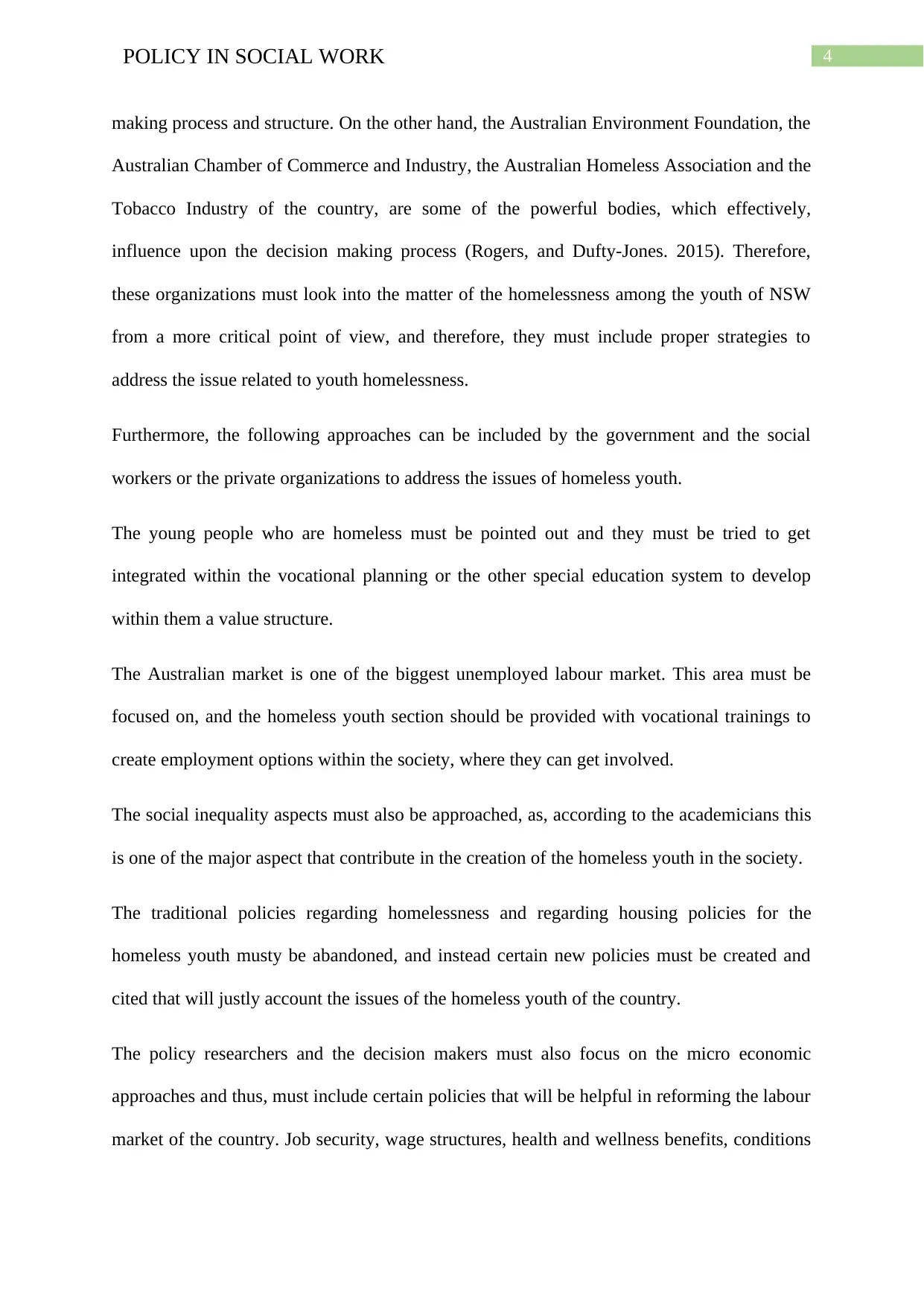
4POLICY IN SOCIAL WORK
making process and structure. On the other hand, the Australian Environment Foundation, the
Australian Chamber of Commerce and Industry, the Australian Homeless Association and the
Tobacco Industry of the country, are some of the powerful bodies, which effectively,
influence upon the decision making process (Rogers, and Dufty-Jones. 2015). Therefore,
these organizations must look into the matter of the homelessness among the youth of NSW
from a more critical point of view, and therefore, they must include proper strategies to
address the issue related to youth homelessness.
Furthermore, the following approaches can be included by the government and the social
workers or the private organizations to address the issues of homeless youth.
The young people who are homeless must be pointed out and they must be tried to get
integrated within the vocational planning or the other special education system to develop
within them a value structure.
The Australian market is one of the biggest unemployed labour market. This area must be
focused on, and the homeless youth section should be provided with vocational trainings to
create employment options within the society, where they can get involved.
The social inequality aspects must also be approached, as, according to the academicians this
is one of the major aspect that contribute in the creation of the homeless youth in the society.
The traditional policies regarding homelessness and regarding housing policies for the
homeless youth musty be abandoned, and instead certain new policies must be created and
cited that will justly account the issues of the homeless youth of the country.
The policy researchers and the decision makers must also focus on the micro economic
approaches and thus, must include certain policies that will be helpful in reforming the labour
market of the country. Job security, wage structures, health and wellness benefits, conditions
making process and structure. On the other hand, the Australian Environment Foundation, the
Australian Chamber of Commerce and Industry, the Australian Homeless Association and the
Tobacco Industry of the country, are some of the powerful bodies, which effectively,
influence upon the decision making process (Rogers, and Dufty-Jones. 2015). Therefore,
these organizations must look into the matter of the homelessness among the youth of NSW
from a more critical point of view, and therefore, they must include proper strategies to
address the issue related to youth homelessness.
Furthermore, the following approaches can be included by the government and the social
workers or the private organizations to address the issues of homeless youth.
The young people who are homeless must be pointed out and they must be tried to get
integrated within the vocational planning or the other special education system to develop
within them a value structure.
The Australian market is one of the biggest unemployed labour market. This area must be
focused on, and the homeless youth section should be provided with vocational trainings to
create employment options within the society, where they can get involved.
The social inequality aspects must also be approached, as, according to the academicians this
is one of the major aspect that contribute in the creation of the homeless youth in the society.
The traditional policies regarding homelessness and regarding housing policies for the
homeless youth musty be abandoned, and instead certain new policies must be created and
cited that will justly account the issues of the homeless youth of the country.
The policy researchers and the decision makers must also focus on the micro economic
approaches and thus, must include certain policies that will be helpful in reforming the labour
market of the country. Job security, wage structures, health and wellness benefits, conditions
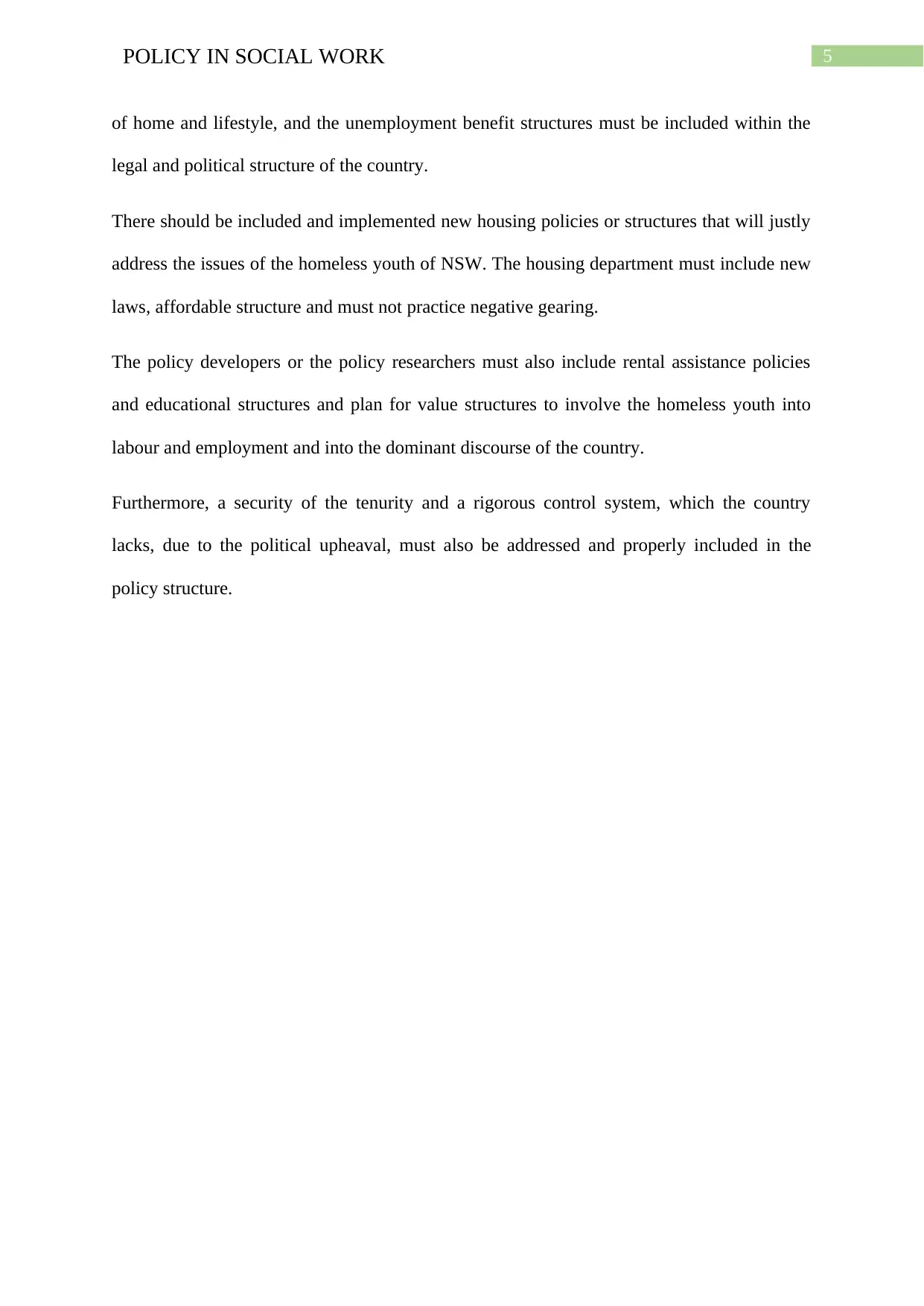
5POLICY IN SOCIAL WORK
of home and lifestyle, and the unemployment benefit structures must be included within the
legal and political structure of the country.
There should be included and implemented new housing policies or structures that will justly
address the issues of the homeless youth of NSW. The housing department must include new
laws, affordable structure and must not practice negative gearing.
The policy developers or the policy researchers must also include rental assistance policies
and educational structures and plan for value structures to involve the homeless youth into
labour and employment and into the dominant discourse of the country.
Furthermore, a security of the tenurity and a rigorous control system, which the country
lacks, due to the political upheaval, must also be addressed and properly included in the
policy structure.
of home and lifestyle, and the unemployment benefit structures must be included within the
legal and political structure of the country.
There should be included and implemented new housing policies or structures that will justly
address the issues of the homeless youth of NSW. The housing department must include new
laws, affordable structure and must not practice negative gearing.
The policy developers or the policy researchers must also include rental assistance policies
and educational structures and plan for value structures to involve the homeless youth into
labour and employment and into the dominant discourse of the country.
Furthermore, a security of the tenurity and a rigorous control system, which the country
lacks, due to the political upheaval, must also be addressed and properly included in the
policy structure.
⊘ This is a preview!⊘
Do you want full access?
Subscribe today to unlock all pages.

Trusted by 1+ million students worldwide
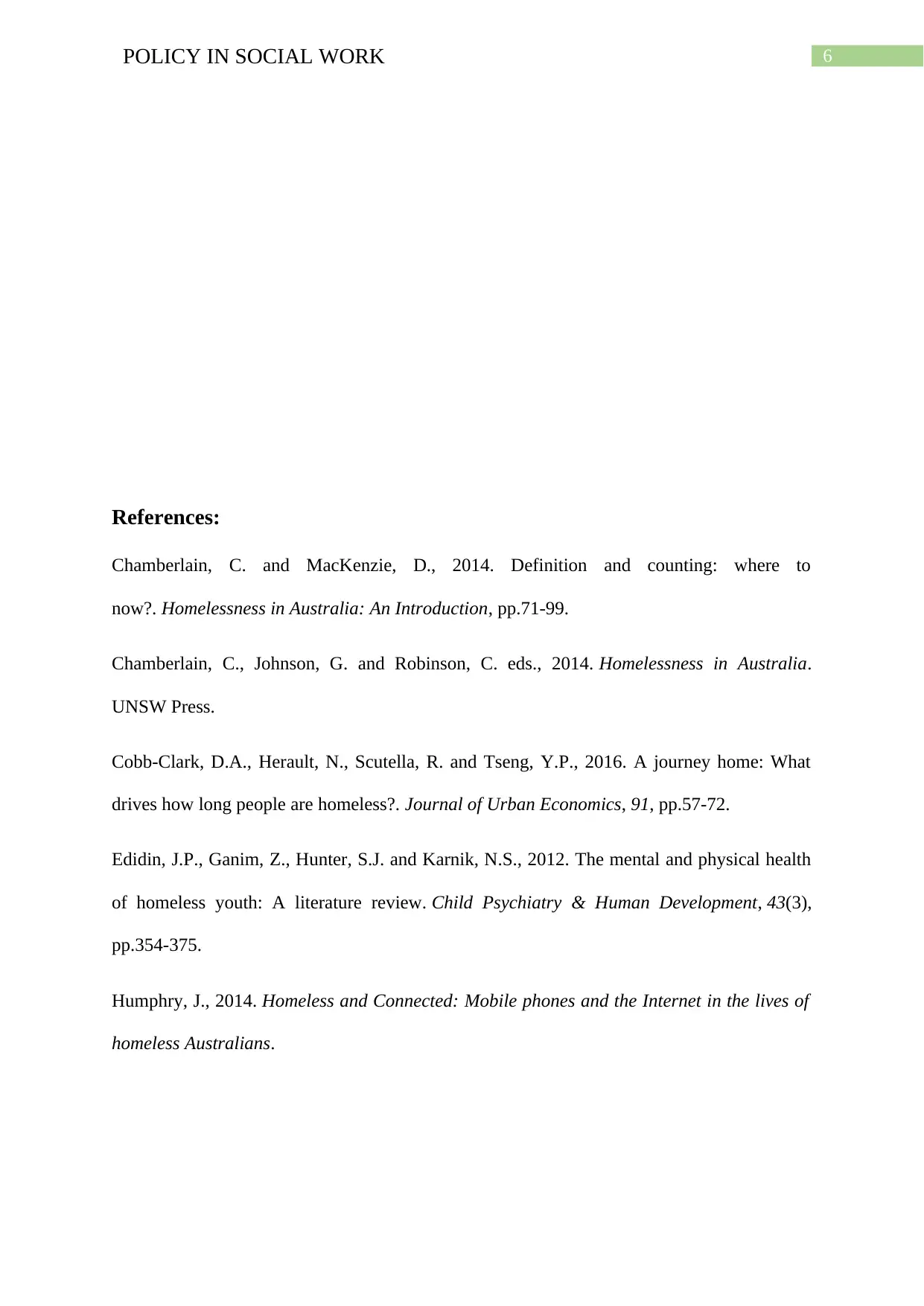
6POLICY IN SOCIAL WORK
References:
Chamberlain, C. and MacKenzie, D., 2014. Definition and counting: where to
now?. Homelessness in Australia: An Introduction, pp.71-99.
Chamberlain, C., Johnson, G. and Robinson, C. eds., 2014. Homelessness in Australia.
UNSW Press.
Cobb-Clark, D.A., Herault, N., Scutella, R. and Tseng, Y.P., 2016. A journey home: What
drives how long people are homeless?. Journal of Urban Economics, 91, pp.57-72.
Edidin, J.P., Ganim, Z., Hunter, S.J. and Karnik, N.S., 2012. The mental and physical health
of homeless youth: A literature review. Child Psychiatry & Human Development, 43(3),
pp.354-375.
Humphry, J., 2014. Homeless and Connected: Mobile phones and the Internet in the lives of
homeless Australians.
References:
Chamberlain, C. and MacKenzie, D., 2014. Definition and counting: where to
now?. Homelessness in Australia: An Introduction, pp.71-99.
Chamberlain, C., Johnson, G. and Robinson, C. eds., 2014. Homelessness in Australia.
UNSW Press.
Cobb-Clark, D.A., Herault, N., Scutella, R. and Tseng, Y.P., 2016. A journey home: What
drives how long people are homeless?. Journal of Urban Economics, 91, pp.57-72.
Edidin, J.P., Ganim, Z., Hunter, S.J. and Karnik, N.S., 2012. The mental and physical health
of homeless youth: A literature review. Child Psychiatry & Human Development, 43(3),
pp.354-375.
Humphry, J., 2014. Homeless and Connected: Mobile phones and the Internet in the lives of
homeless Australians.
Paraphrase This Document
Need a fresh take? Get an instant paraphrase of this document with our AI Paraphraser
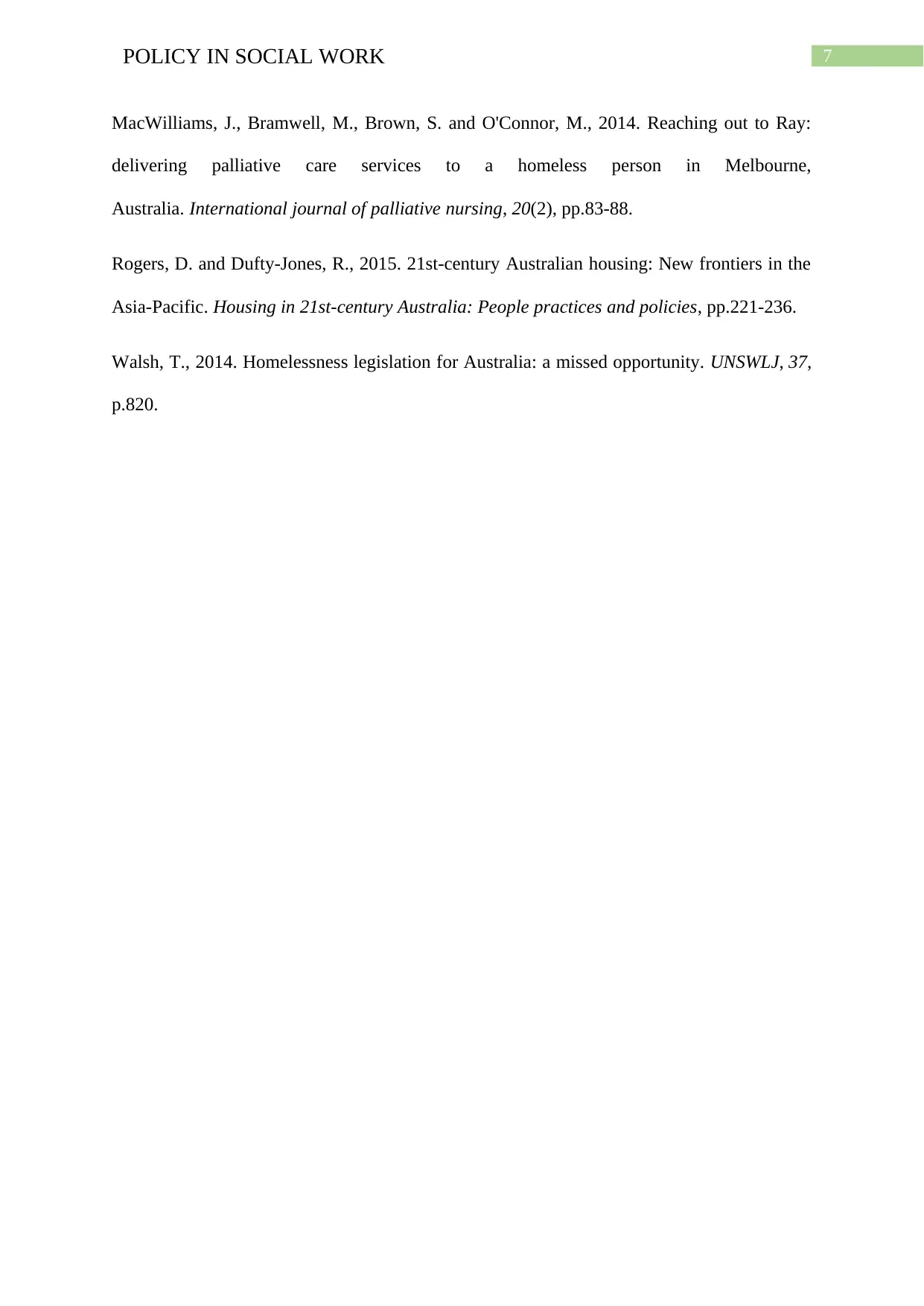
7POLICY IN SOCIAL WORK
MacWilliams, J., Bramwell, M., Brown, S. and O'Connor, M., 2014. Reaching out to Ray:
delivering palliative care services to a homeless person in Melbourne,
Australia. International journal of palliative nursing, 20(2), pp.83-88.
Rogers, D. and Dufty-Jones, R., 2015. 21st-century Australian housing: New frontiers in the
Asia-Pacific. Housing in 21st-century Australia: People practices and policies, pp.221-236.
Walsh, T., 2014. Homelessness legislation for Australia: a missed opportunity. UNSWLJ, 37,
p.820.
MacWilliams, J., Bramwell, M., Brown, S. and O'Connor, M., 2014. Reaching out to Ray:
delivering palliative care services to a homeless person in Melbourne,
Australia. International journal of palliative nursing, 20(2), pp.83-88.
Rogers, D. and Dufty-Jones, R., 2015. 21st-century Australian housing: New frontiers in the
Asia-Pacific. Housing in 21st-century Australia: People practices and policies, pp.221-236.
Walsh, T., 2014. Homelessness legislation for Australia: a missed opportunity. UNSWLJ, 37,
p.820.
1 out of 8
Related Documents
Your All-in-One AI-Powered Toolkit for Academic Success.
+13062052269
info@desklib.com
Available 24*7 on WhatsApp / Email
![[object Object]](/_next/static/media/star-bottom.7253800d.svg)
Unlock your academic potential
Copyright © 2020–2025 A2Z Services. All Rights Reserved. Developed and managed by ZUCOL.





